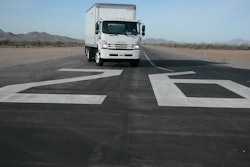
Electrification has hit trucking like a tidal wave with notable debuts of tractors from the likes of Cummins, Fuso and Tesla last year.
But just like their diesel counterparts, an electric truck doesn’t make the same sense to all concerned transportation segments and Julie Furber, executive director of Cummins’ electrification business development, says the battery-powered near-term outlook for long-haul applications isn’t rosy.
“For a line-haul truck application, we think a fully electric vehicle does not make sense economically, because of the weight [needed to supply battery power],” she says.
Truck manufactures have targeted local routes with electric trucks to-date. Tesla, for example, says it will be among its first customers for the company’s electric Semi, using it to shuttle freight from Hawthorne, Calif. to its Nevada Gigafactory.
Of North American truck OEMs, Cummins was among the first to introduce a heavy electric concept. The company’s 100-mile range, Class 7 Aeos tractor was designed to serve as a demonstrator vehicle for vocational applications, urban delivery operations, port drayage and terminal container handling.
“Short range and port applications make the most sense,” Furber says of electricity’s role in transportation, adding much work is needed to eliminate battery weight and improve energy density for an electric long-haul truck.

The jump to truck electrification isn’t likely to be a fast one, Furber adds, predicting hybrids will offer a method to test the waters of electrification.
“In the next couple of decades, I think what you may see start to appear is more hybrid-type vehicles,” she says. “If you want a cost-effective solution, I think a hybrid – with a smaller engine where it’s running on the highway and when it gets into a zero emissions zone or a no-idling situation or a stop and start situation – it can run fully electric.”
This past November, a Mack Pinnacle prototype equipped with a proprietary and fully integrated plug-in hybrid electric driveline participated in a zero-emission eHighway demonstration near the ports of Los Angeles and Long Beach.
Nikola Motor Company will deploy hybrid technology on the fuel cell powered tractor the company expects to begin testing next year. Company founder Trevor Milton says combining the electric powertrain with a hydrogen power supply relieves range anxiety associated with most electrics, but offers drivers a way to quickly refuel versus recharging while still allowing for zero-emissions.
Nikola and Toyota are each in the process of developing a hydrogen infrastructure, and Furber says similar work will have to be done for electricity.
“You’ve got to have a charging infrastructure,” she notes. “No matter how fast you can charge, you have to be able to stop somewhere and charge. That charging infrastructure does not exist and it’s not clear to me whose responsibility it is to put in all those charging stations.”
One of the positives of innovation is that it brings many non-traditional players and outsiders into the market, and that has happened with electrification in trucking.
Furber says many universities have ongoing battery chemistry and density programs while some companies not otherwise associated with trucking have applicable technologies to bring to market. And just because a company like Tesla has existing experience in the battery-powered vehicle space, Furber says that doesn’t necessarily give them any advantage.
“It’s not that easy to scale up from passenger car. The work that a passenger car does compared who what commercial vehicles do is completely different. I don’t think you can take passenger car motors and put them on a truck. I don’t think you can take passenger car batteries and put them on a truck,” she says. “One of the things you’ve got to remember is to succeed in this business, you’ve really got to understand the [trucking] business and certainly the [trucking] OEMs do that.”
Still many fleets have embraced the shift toward electric trucks with Tesla having secured more than 400 known orders since its November debut, and orders for the Nikola One tractor piling up by the thousands – each customer attracted to its zero-emissions and the truck’s perceived reduced cost of ownership.
“Theoretically, maintenance costs should be lower,” Furber says. “There’s fewer moving parts and fewer things to go wrong. There’s no doubt we expect the maintenance costs to be lower, but we don’t know how much lower yet.”












